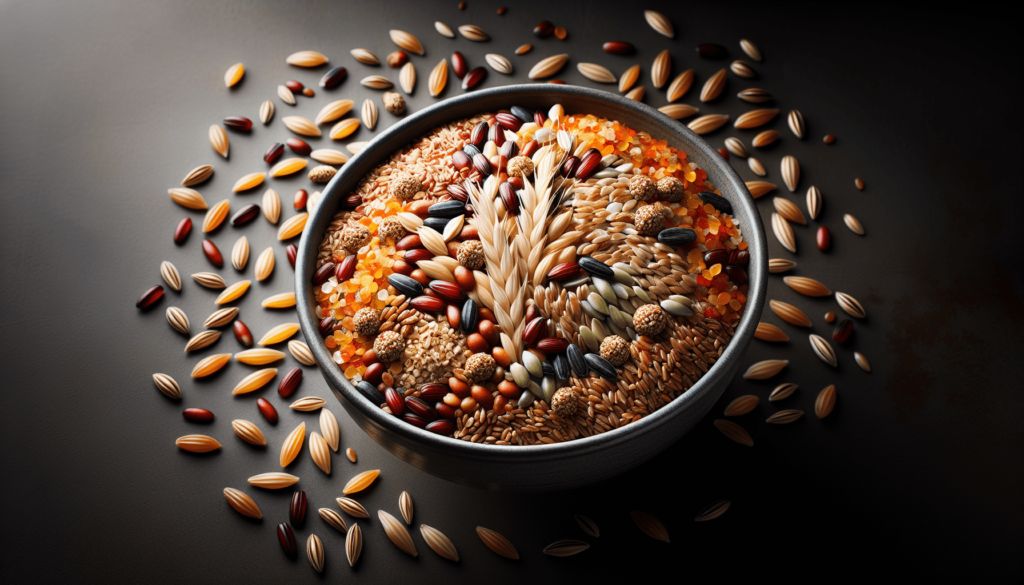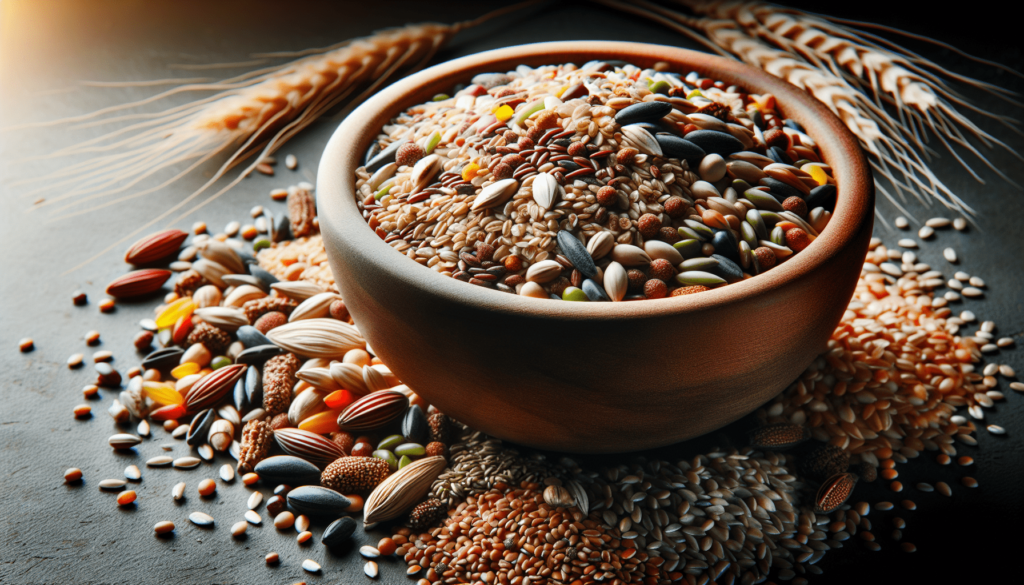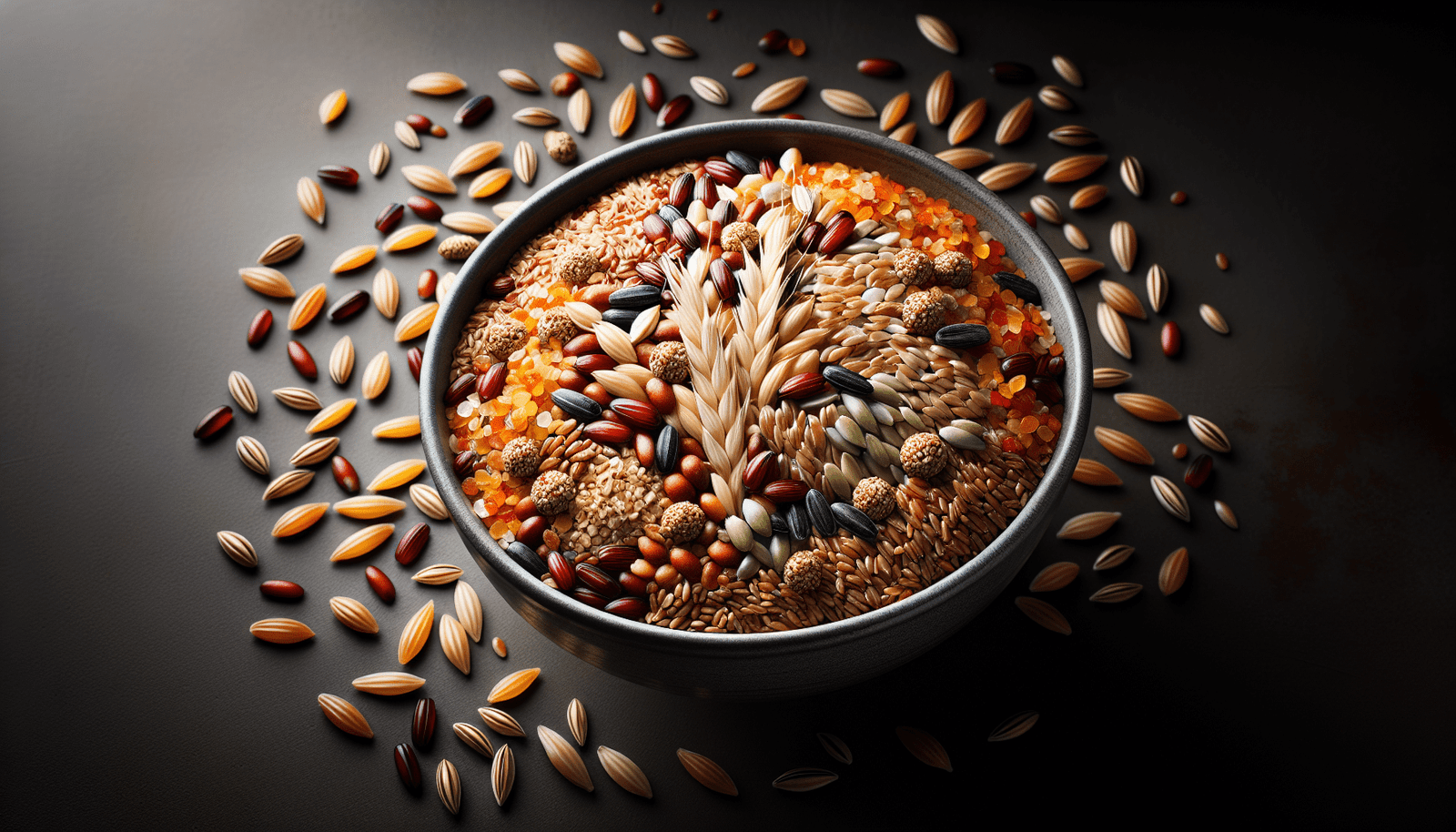If you’re looking to boost your gut health, whole grains are your trusty companions! Not only are they packed with essential nutrients, but they also promote a healthy gut microbiome. But how do you unleash their full potential? Discover in this article a variety of simple and delicious ways to prepare whole grains to optimize their gut health benefits. From hearty salads to comforting porridge, you’ll find a range of options that will leave your taste buds satisfied and your gut thriving.

Soak the grains
Benefits of soaking grains
Soaking grains before cooking them has several benefits for gut health. Firstly, soaking helps break down the phytic acid present in grains, which can inhibit the absorption of nutrients in the body. By soaking grains, you are making the nutrients more bioavailable, allowing your body to absorb them more effectively.
Secondly, soaking grains helps to reduce anti-nutrients such as lectins and enzyme inhibitors. These compounds can irritate the gut lining and interfere with digestion. Soaking grains neutralizes these substances, making them easier to digest and reducing the chances of digestive upset or irritation.
How to soak grains
To soak grains, simply place them in a bowl and cover them with water. The ratio should be approximately 1 cup of grains to 2-3 cups of water. Add a splash of apple cider vinegar or lemon juice to the water to further enhance the nutrient absorption and digestion process. Let the grains soak for at least 8 hours or overnight. After soaking, rinse the grains well before cooking them using your preferred cooking method.
Ferment the grains
Importance of fermenting grains
Fermenting grains is another method that can enhance their gut health benefits. Fermentation not only improves the digestibility of grains but also increases their nutritional value. During the fermentation process, beneficial bacteria consume the sugars and starches in the grains, producing lactic acid and creating a more probiotic-rich environment.
One of the main benefits of fermenting grains is the production of beneficial enzymes and increased vitamin and mineral content. Fermentation helps to break down the complex carbohydrates in grains, making them easier to digest. Additionally, the beneficial bacteria produced during fermentation help to improve gut health by promoting a healthy balance of gut flora.
Different fermentation methods for grains
There are various methods you can use to ferment grains. One popular method is sourdough fermentation, where you make a sourdough starter using flour and water. This starter is then mixed with grains to create sourdough bread or other fermented grain products.
Another method is to use a brine solution to ferment grains. This involves soaking the grains in a solution of salt and water, allowing the beneficial bacteria to proliferate and ferment the grains. This method is commonly used to ferment vegetables but can also be applied to grains.
Cook the grains
Importance of cooking grains
Cooking grains is an essential step to make them palatable and safe to consume. While soaking and fermenting grains can enhance their nutritional value and improve digestion, cooking is necessary to ensure they are thoroughly cooked and free from harmful bacteria or toxins.
Cooking grains also helps to make them easier to digest as the heat breaks down complex carbohydrates and proteins, making them more readily available for absorption by the body. Additionally, cooking can enhance the flavors and textures of grains, making them more enjoyable to eat.
Different cooking methods for grains
There are several cooking methods you can use to prepare grains. Boiling is a common method where grains are cooked in a large quantity of water until they are tender. This method works well for softer grains like rice or quinoa.
Steaming is another popular method, especially for grains like couscous or bulgur. Steaming helps to preserve the nutrients in grains and gives them a light and fluffy texture.
Another option is baking or roasting grains, which can add a unique flavor profile to the grains. This method is often used with heartier grains like farro or barley, and it can be a great way to add depth to grain-based dishes.
Sprout the grains
Benefits of sprouting grains
Sprouting grains is a process where grains are soaked and allowed to germinate, resulting in the growth of a small sprout. Sprouting grains not only enhances their nutritional value but also makes them easier to digest. During the sprouting process, enzymes are activated, breaking down complex carbohydrates and proteins into simpler forms, making them more digestible.
Additionally, sprouting grains increases their vitamin and mineral content. Sprouts contain higher levels of vitamins A, C, and B vitamins compared to unsprouted grains. They are also rich in enzymes, which can aid digestion and improve nutrient absorption.
How to sprout grains
To sprout grains, start by soaking them in water for the recommended soaking time. After soaking, drain the water and rinse the grains thoroughly. Place the grains in a sprouting container or jar. Cover the jar with a mesh lid or a piece of breathable fabric to allow air circulation. Rinse the grains twice a day, ensuring they stay moist but not waterlogged. After a few days, you will start to see sprouts forming. Once the sprouts are around half an inch long, they are ready to be consumed or used in recipes.

Combine grains with probiotics
Why combine grains with probiotics
Combining grains with probiotics can further enhance their gut health benefits. Probiotics are beneficial bacteria that support a healthy gut microbiome. Pairing them with grains ensures a diverse range of good bacteria that can promote better digestion and overall gut health.
Probiotics help to improve the balance of gut flora, reducing the risk of digestive issues such as bloating, gas, and constipation. They can also boost the immune system and support overall wellbeing. When paired with grains, probiotics work synergistically to promote optimal gut health.
Sources of probiotics to pair with grains
There are various sources of probiotics that can be paired with grains. Fermented foods such as yogurt, kefir, sauerkraut, and kimchi are excellent sources of probiotics. Adding a dollop of yogurt to a grain bowl or incorporating sauerkraut into a grain-based salad can introduce probiotics to your meal.
Probiotic supplements are another option if you’re looking to increase your probiotic intake. Look for high-quality supplements that contain a variety of beneficial bacterial strains.
Add prebiotic-rich ingredients
Importance of prebiotics for gut health
Prebiotics are dietary fibers that serve as food for probiotics and promote their growth in the gut. Including prebiotic-rich ingredients in your grain dishes can help nourish the beneficial bacteria in your digestive system, supporting a healthy gut microbiome.
Prebiotics play a crucial role in maintaining a balanced gut flora. They help to stimulate the growth of beneficial bacteria, which in turn can improve digestion, enhance nutrient absorption, and strengthen the immune system.
Examples of prebiotic-rich ingredients to add to grains
There are various prebiotic-rich ingredients you can add to your grain recipes. Some examples include onions, garlic, leeks, asparagus, bananas, chicory root, and Jerusalem artichokes. Try incorporating these ingredients into your grain-based dishes to boost their prebiotic content and support gut health.
Incorporate fermented vegetables
Benefits of fermented vegetables
Fermented vegetables are not only delicious and tangy but also offer numerous gut health benefits. Just like fermented grains, fermented vegetables are rich in beneficial bacteria that can improve digestion, support a healthy immune system, and aid in nutrient absorption.
Fermented vegetables contain lactic acid bacteria, which can help restore the balance of gut flora and promote optimal gut health. These bacteria produce enzymes that break down food, making it easier to digest. They can also help to alleviate symptoms of digestive disorders such as bloating and indigestion.
Ideas for incorporating fermented vegetables into grain recipes
There are countless ways to incorporate fermented vegetables into your grain recipes. You can add them as a topping to grain bowls, stir them into grain-based salads, or use them as a flavorful component in grain wraps or sandwiches. The tangy and probiotic-rich nature of fermented vegetables adds a delightful twist to grain dishes while boosting their gut health benefits.
Experiment with alternative cooking methods
Exploring alternative cooking methods for grains
While boiling and steaming are the most common cooking methods for grains, there are alternative methods that can add variety and enhance the nutritional profile of the grains. Experimenting with these alternative cooking methods can help you discover new flavors and textures while optimizing the gut health benefits of grains.
Examples of alternative cooking methods
One alternative cooking method is toasting the grains before cooking them. Toasting grains like quinoa or oats in a dry skillet adds depth and nuttiness to their flavor. This method works well for grain-based salads or side dishes.
Another alternative method is pressure cooking. Using a pressure cooker reduces the cooking time significantly, while still ensuring that the grains are thoroughly cooked. This method is particularly useful for larger grains like brown rice or barley.
You can also try baking grains, similar to baking bread or muffins. Baking grains with other ingredients can create flavorful casseroles or grain-based bars that can be enjoyed as healthy snacks.
Include gut-friendly seasonings
Benefits of gut-friendly seasonings
Using gut-friendly seasonings can further enhance the gut health benefits of grains. Certain herbs and spices have antimicrobial properties that can help balance gut flora and support digestive health. Additionally, using flavorful seasonings can make your grain dishes more enjoyable and satisfying.
Types of seasonings to enhance gut health benefits of grains
Some gut-friendly seasonings to consider adding to your grains include ginger, turmeric, garlic, cumin, coriander, and oregano. These seasonings have been used for centuries for their digestive and immune-boosting properties. Experiment with different combinations to create unique flavor profiles while reaping the gut health benefits.
Pair grains with gut-healthy foods
Foods that complement the gut health benefits of grains
Pairing grains with other gut-healthy foods can create balanced and nutritious meals that support optimal gut health. Foods such as lean proteins, leafy greens, fermented dairy products, and antioxidant-rich fruits and vegetables can provide a diverse range of nutrients and promote a healthy gut microbiome.
Recipes or meal ideas combining grains with other gut-healthy foods
Here are a few meal ideas combining grains with other gut-healthy foods:
-
Quinoa and Grilled Chicken Salad with Mixed Greens: Combine cooked quinoa with grilled chicken, a variety of mixed greens, cherry tomatoes, cucumber, and a lemon-tahini dressing. This salad provides a balance of carbohydrates, protein, and gut-friendly leafy greens.
-
Whole Grain Pasta with Roasted Vegetables and Fermented Goat Cheese: Toss cooked whole grain pasta with roasted seasonal vegetables like bell peppers, zucchini, and eggplant. Top with crumbled fermented goat cheese for added probiotics and flavor.
-
Brown Rice Stir-Fry with Tofu and Broccoli: Cook brown rice and stir-fry it with tofu, broccoli, carrots, and snap peas. Add a homemade sauce made from gut-healthy ingredients like garlic, ginger, tamari, and a touch of honey for a flavorful and nutritious meal.
Remember to experiment with different grain varieties, cooking methods, seasonings, and complementary foods to create a diverse and gut-friendly diet.
Incorporating these methods and techniques when preparing whole grains can significantly optimize their gut health benefits. From soaking and fermenting to cooking and sprouting, each step contributes to enhanced nutrient absorption, better digestion, and a healthier gut microbiome. By adding probiotics, prebiotic-rich ingredients, and fermented vegetables, and exploring alternative cooking methods, you can create delicious and gut-friendly grain-based dishes that nourish your body and support optimal gut health. So go ahead, get creative in the kitchen and start enjoying the many benefits of preparing whole grains in a gut-healthy way!

